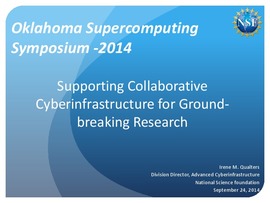| dc.contributor.author | Qualters, Irene | |
| dc.date.accessioned | 2015-07-16T18:13:03Z | |
| dc.date.available | 2015-07-16T18:13:03Z | |
| dc.date.issued | 2014-09-24 | |
| dc.identifier.uri | https://hdl.handle.net/11244/15235 | |
| dc.description | Irene M. Qualters is currently Division Director of Advanced Cyberinfrastructure (ACI) at the National Science Foundation (NSF). ACI is responsible for programs with a total annual budget in FY2013 of over $200 million. These programs support the acquisition, development, and provisioning of state-of-the-art cyberinfrastructure resources, tools, and services essential to the conduct of 21st century science and engineering research and education. ACI is also responsible for the NSF-wide vision, strategy, planning and coordination for research cyberinfrastructure. She joined NSF as a Program Director in December 2009, participating in multidisciplinary, interagency and international activities as well as overseeing several major computational projects within the division's portfolio, including the Blue Waters project at the National Center for Supercomputing Applications (NCSA) at the University of Illinois at Urbana-Champaign (UIUC) and the Stampede project at Texas Advanced Computing Center (TACC) at the University of Texas at Austin. Irene has a Master's degree in Computer Science. Prior to beginning her NSF responsibilities, she had a distinguished 30-year career in industry, with executive leadership positions for research and development organizations within the technology sector. During her twenty years at Cray Research, in increasingly larger leadership roles, she participated in the development of the first commercially successful vectorizing compiler, the first multiprocessor version of Unix, and Cray's landmark massively parallel computer, the T3E. Subsequently, for six years, as Vice President, she led the Research Information Systems for Merck Research Labs (MRL). She is expert in parallel computer system architectures and in a wide variety of software from scientific applications to compilers to file systems and operating systems. | en_US |
| dc.description.abstract | Ubiquity in mobile devices, social networks, sensors, advanced computing and instruments have created a complex data-rich environment ripe for new scientific and engineering advances. In this world of computational and data-enabled science and engineering, a dynamic and innovative yet cohesive cyberinfrastructure of technologies, services, and people, is fundamental to all aspects of the discovery process. This talk will focus on National Science Foundation's vision, strategy and support of collaborative cyberinfrastructure. | en_US |
| dc.description.sponsorship | The University of Oklahoma Supercomputing Center for Education and Research (OSCER),
The University of Oklahoma's Department of Information Technology,
The Oklahoma Supercomputing Symposium 2014,
The National Science Foundation
Advanced Cyberinfrastructure (ACI) | en_US |
| dc.language | en | en_US |
| dc.subject | Computer Science. | en_US |
| dc.subject | Cyberinfrastructure | en_US |
| dc.subject | Research | en_US |
| dc.subject | Technology | en_US |
| dc.title | Collaborative Cyberinfrastructure to Explore 21st Century Research and Education Frontiers | en_US |
| dc.type | Presentation | en_US |
| dc.description.peerreview | No | en_US |
| ou.group | Oklahoma Supercomputing::Oklahoma Supercomputing Symposium::2014 | en_US |
